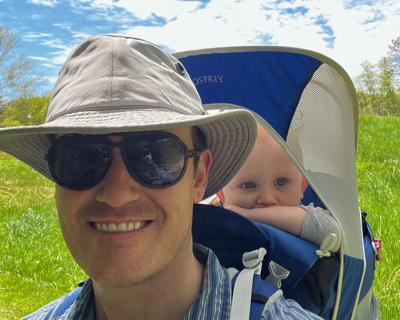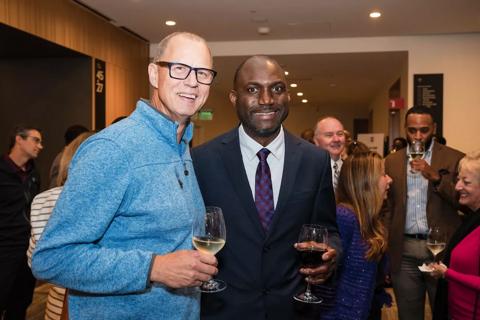Advertisement

Dr. Marcos Viguera, seated, is surrounded by his daughter Dr. Adele Viguera and son-in-law Dr. Stephen Jones.
Advertisement
Cleveland Clinic is a non-profit academic medical center. Advertising on our site helps support our mission. We do not endorse non-Cleveland Clinic products or services. Policy
Marc Viguera, MD, an anesthesiologist from Buffalo, NY, and his daughter, Adele C. Viguera, MD (Staff’07), a Cleveland Clinic psychiatrist, have made a generous gift establishing The Viguera Family Endowed Chair in Neuroradiology Research at Cleveland Clinic. The chair will provide support for current and future endeavors related to neuroradiology research at both Cleveland Clinic’s Imaging Institute and the Lerner Research Institute.
Stephen E. Jones, MD, PhD (Staff’07), Vice-Chair for Research and Academic Affairs in Cleveland Clinic’s Imaging Institute and a neuroradiologist in the Neurologic Institute, will be the inaugural chair holder. He was appointed to the position by Serpil Erzurum, MD (Staff’93), Chair of the Lerner Research Institute, and Gregory Borkowski, MD, FACR (IM’74, DR’79), Chair of the Imaging Institute.
Emigration and a legacy of patient care
Dr. Marc Viguera and his wife, Dr. Luisa Casals Viguera, emigrated from Barcelona, Spain. He arrived in the U.S. in June 1962, and she joined him in January 1963. They sought to escape the oppressive dictatorship of General Francisco Franco, which had imprisoned Dr. Viguera’s father for a year and persecuted his family. “We came to this country as immigrants, knowing no one,” he says. They landed in Cincinnati, Ohio, where he had an internship at The Good Samaritan Hospital, and he went on to complete his residency at Buffalo General Hospital in 1964. “We spent the rest of our lives in the United States,” he says. “This is a great country and it has been marvelous to me and my family. We are proud to be Americans.”
Advertisement
Dr. Marc Viguera served as Chief of the Buffalo General Hospital Department of Anesthesia for over 20 years and an associate professor at UB Medical School. His wife, who passed away in 2008, was an attending physician at the University at Buffalo Student Health Services and a clinical assistant professor at the Medical School for over 30 years. She was well-respected by the university’s international students for her ability to relate to them and for her expertise in treating complex tropical diseases. Her former students frequently invited her overseas when they achieved prominent positions in their respective countries.
Dr. Adele C. Viguera recalls her mother’s passion for medicine. As a young girl, she assisted her father, a physician in the Catalan countryside near Barcelona. “My mother would often accompany him on house calls or assist him in his home office. My grandfather served as a great role model for our family and what it truly meant to be a physician. Like my grandfather, my mother was also a great humanitarian who understood the suffering of others and advocated for their needs.”
Her mother and father shared a passion for patient care, Dr. Adele Viguera says, and they set an example that inspired her to follow in their footsteps.
Dr. Viguera and Dr. Jones joined Cleveland Clinic’s staff in 2007. Dr. Viguera cares for patients and conducts research focused on women’s mental health. Dr. Jones is both a staff neuroradiologist and active researcher, with a unique background. Prior to medical school, he earned a PhD in nuclear fusion, switched to X-ray astrophysics on the MIT research staff, and then became interested in brain science. Neuroradiology can benefit from the synergy of different fields, particularly when it involves large and complicated equipment, he observes. Today, he practices neuroradiology and is known for his work with the 7T (7 Tesla) MRI machine. In addition, he collaborates with multiple Cleveland Clinic departments.
Advertisement
Dr. Jones’ research
As chairholder, Dr. Jones will have support for his innovative research in imaging, including the 7-Tesla MRI machine. There are only 90 7-Tesla machines around the world. Cleveland Clinic, which has one, was one of the early institutions to acquire the machine in 2013. He is exploring a wide range of uses, particularly using its ability to see better detail and smaller lesions. For example, this could include looking for micrometastasis only a few millimeters in size.
“With lower field MRI, we often look for enhancing small lesions,” he said in an interview for Cleveland Clinic’s Neuro Pathways podcast. “Wouldn’t it be good if you had high-definition MRI that could see these at a smaller and earlier stage and lead to earlier treatment? Another area is multiple sclerosis. With 7-Tesla, we can see a feature of MS lesions that is very small and helps to identify it as a true multiple sclerosis plaque.”
Deep brain stimulation also benefits from use of the 7-Tesla. “Surgeons have to know where to put the electrodes in order to have an effect,” he said. “One treatment we do is for essential tremor, or in Parkinson’s, where patients have debilitating shaking of their hands. If we can find the tiny little lesion in the thalamus, for example, and make a lesion only 3 or 4 millimeters in size, that tremor can go away.”
Dr. Jones also is exploring combining 7-Tesla with other aspects of MRI. “We can look for brain connectivity, resting state connectivity, diffusion tensor connectivity, and we can try to see on an individual patient basis how we can help our surgeons target these locations,” he said.
Also of interest to him is high-intensity focused ultrasound (HIFU), “another very exciting, science fiction-like technology where, with our neurosurgery colleagues, we can do brain surgery inside the MRI without a scalpel. Again, it all comes back to where to target.” Using 7-Tesla with HIFU could really improve patient care, he said.
Much of Dr. Jones’ work is in epilepsy. “Sometimes, we’re looking for tiny lesions in someone’s brain, on the cortex, for example, and as a physician-scientist, this is a very exciting field to work in because epilepsy patients are typically younger. If you can just find a little lesion in the brain and have a surgeon excise it, you may buy someone a lifelong seizure freedom, and that’s a tremendous thing.”
Another application would be for degenerative brain disorders related to microhemorrhages. “The 7-Tesla MRI is more sensitive to hemorrhagic products, and what we can see in some people is exquisite numbers of microhemorrhages that have a cortically based distribution,” he said. “The 7-Tesla can just nail a diagnosis because it can show you the numerous microhemorrhages in a cortical or gyriform pattern.”
Advertisement
Dr. Marc Viguera says he is excited to support these studies. “I’m 89 years old and try to follow closely all the research, such as the special Tesla MRI. I’m fascinated by the future potential of such machines. Most patients do not know their neuroradiologist, so philanthropy in this area is not as robust as in other field of medicine. It is very important to support the people behind the scenes and their important research. With this chair, support will go on for many years to help sustain research efforts in neuroradiology at the Cleveland Clinic to benefit patients now and in the future.”
Advertisement
Advertisement

We celebrate the exceptional achievements of four future alumni

Meet Hardeep Phull, MD (CCLCM’11)

Meet William Tierney, MD, MS (CCLCM’16, OTO’18)

Meet Samuel Omotoye, MD (CARD/E'15)